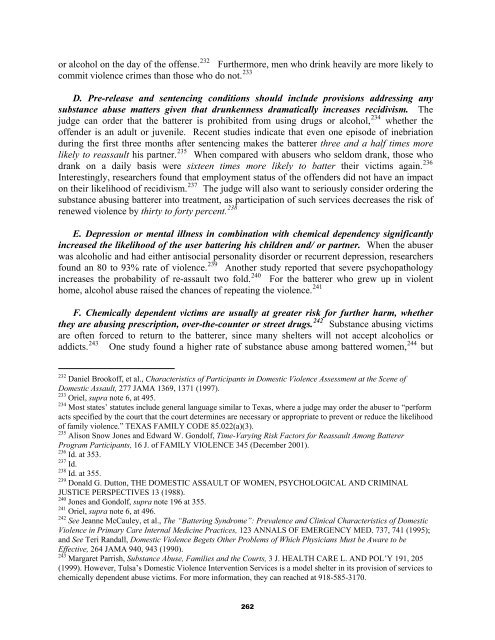A Judge’s Guide
A Judge’s Guide
A Judge’s Guide
Create successful ePaper yourself
Turn your PDF publications into a flip-book with our unique Google optimized e-Paper software.
or alcohol on the day of the offense. 232 Furthermore, men who drink heavily are more likely to<br />
commit violence crimes than those who do not. 233<br />
D. Pre-release and sentencing conditions should include provisions addressing any<br />
substance abuse matters given that drunkenness dramatically increases recidivism. The<br />
judge can order that the batterer is prohibited from using drugs or alcohol, 234 whether the<br />
offender is an adult or juvenile. Recent studies indicate that even one episode of inebriation<br />
during the first three months after sentencing makes the batterer three and a half times more<br />
likely to reassault his partner. 235 When compared with abusers who seldom drank, those who<br />
drank on a daily basis were sixteen times more likely to batter their victims again. 236<br />
Interestingly, researchers found that employment status of the offenders did not have an impact<br />
on their likelihood of recidivism. 237 The judge will also want to seriously consider ordering the<br />
substance abusing batterer into treatment, as participation of such services decreases the risk of<br />
renewed violence by thirty to forty percent. 238<br />
E. Depression or mental illness in combination with chemical dependency significantly<br />
increased the likelihood of the user battering his children and/ or partner. When the abuser<br />
was alcoholic and had either antisocial personality disorder or recurrent depression, researchers<br />
found an 80 to 93% rate of violence. 239 Another study reported that severe psychopathology<br />
increases the probability of re-assault two fold. 240 For the batterer who grew up in violent<br />
home, alcohol abuse raised the chances of repeating the violence. 241<br />
F. Chemically dependent victims are usually at greater risk for further harm, whether<br />
they are abusing prescription, over-the-counter or street drugs. 242 Substance abusing victims<br />
are often forced to return to the batterer, since many shelters will not accept alcoholics or<br />
addicts. 243 One study found a higher rate of substance abuse among battered women, 244 but<br />
232 Daniel Brookoff, et al., Characteristics of Participants in Domestic Violence Assessment at the Scene of<br />
Domestic Assault, 277 JAMA 1369, 1371 (1997).<br />
233 Oriel, supra note 6, at 495.<br />
234 Most states’ statutes include general language similar to Texas, where a judge may order the abuser to “perform<br />
acts specified by the court that the court determines are necessary or appropriate to prevent or reduce the likelihood<br />
of family violence.” TEXAS FAMILY CODE 85.022(a)(3).<br />
235 Alison Snow Jones and Edward W. Gondolf, Time-Varying Risk Factors for Reassault Among Batterer<br />
Program Participants, 16 J. of FAMILY VIOLENCE 345 (December 2001).<br />
236 Id. at 353.<br />
237 Id.<br />
238 Id. at 355.<br />
239 Donald G. Dutton, THE DOMESTIC ASSAULT OF WOMEN, PSYCHOLOGICAL AND CRIMINAL<br />
JUSTICE PERSPECTIVES 13 (1988).<br />
240 Jones and Gondolf, supra note 196 at 355.<br />
241 Oriel, supra note 6, at 496.<br />
242 See Jeanne McCauley, et al., The “Battering Syndrome”: Prevalence and Clinical Characteristics of Domestic<br />
Violence in Primary Care Internal Medicine Practices, 123 ANNALS OF EMERGENCY MED. 737, 741 (1995);<br />
and See Teri Randall, Domestic Violence Begets Other Problems of Which Physicians Must be Aware to be<br />
Effective, 264 JAMA 940, 943 (1990).<br />
243 Margaret Parrish, Substance Abuse, Families and the Courts, 3 J. HEALTH CARE L. AND POL’Y 191, 205<br />
(1999). However, Tulsa’s Domestic Violence Intervention Services is a model shelter in its provision of services to<br />
chemically dependent abuse victims. For more information, they can reached at 918-585-3170.<br />
262


